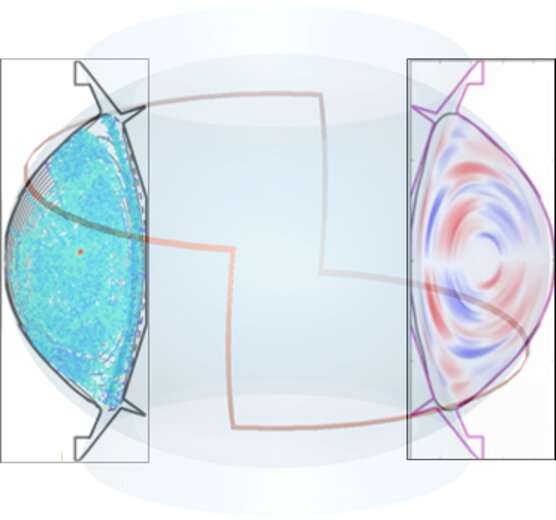Passive-aggressive: New coil stands ready to tame runaway electrons

In the race toward practical fusion energy, tokamaks (donut-shaped plasma devices) are the leading concept—they have achieved better confinement and higher plasma temperatures than any other configuration. Two major magnetic fields are used to contain the plasma: a toroidal field (along the axes of the donut) produced by external coils and the field from a ring current flowing in the plasma itself. The performance of a tokamak, however, comes with an Achilles heel—the possibility of disruptions, a sudden termination of the plasma driven by instabilities in the plasma current. Since the plasma current provides the equilibrium and confinement for the tokamak, the challenge of taming disruptions must be addressed and solved.
As the magnitudes of the plasma current and plasma energy increase, disruptions can cause more damage. As such, they are a particularly important concern for the newest and most powerful machines, such as the SPARC tokamak. SPARC is a compact, high-magnetic-field tokamak under design and in the early stages of construction by a joint team from the Massachusetts Institute of Technology and Commonwealth Fusion Systems. The SPARC plasma is predicted to produce more than 10 times the power than is required to maintain its 250 million F temperatures. All tokamaks of this performance class must develop strategies to protect the machine against disruptions.
A solution, however, may be in hand. Prompted by a theoretical idea from Prof. Allen Boozer of Columbia University, the SPARC design includes an innovative new coil structure which promises fully passive protection from the threat of runaway electrons.
When a tokamak disrupts, the plasma current disappears in a few milliseconds. A fundamental principle in physics, called Faraday's Law, tells us that such a change in current induces an electric field in a direction which tries to maintain the vanishing current. With the plasma collapsing, current is induced in any other nearby electrically conducting material. It can be transferred to the metallic vacuum vessel which surrounds the plasma or to a population of hot electrons which remain after the plasma collapse. It turns out that this latter process can quickly produce an enormous population of relativistic electrons travelling just under the speed of light. These beams, containing millions of amperes of current in relativistic, "runaway" electrons, have the potential to wreak significant damage on plasma facing materials in the vessel. This scenario is a major concern for machines like SPARC or ITER, the international tokamak under construction in France, and one that had seemed to be very difficult to mitigate.
The new coil, which is powered by the disruption itself (via Faraday's law), addresses this scenario by introducing a non-axisymmetric perturbation into the magnetic field structure. When the disruption starts, this perturbation breaks the symmetry, spoils the confinement, and protects the machine by providing a safe mechanism which quickly removes the hot electrons before they can be accelerated to relativistic velocities. This perturbation only grows when the coil is energized by the electric field induced during a disruption, so during normal operations the excellent confinement that is characteristic of a tokamak is maintained.
For the first time, scientists used a suite of powerful computer codes to analyze the energization of such a coil, the response of the plasma and the impact of the resulting perturbation on fast particles. These results, which will be presented in an invited talk at the APS-DPP meeting, confirm the viability of this approach.
A conceptual design for the coil has been developed, with further analysis to come. These will focus on detailed mechanical, thermal and electrical engineering along with considerations imposed by the nuclear environment within which the coil must operate.
More information: Abstract: ZI01.00004. Prevention of disruption driven runaway electrons with a passive non-axisymmetric coil in the SPARC tokamak
Provided by American Physical Society





















